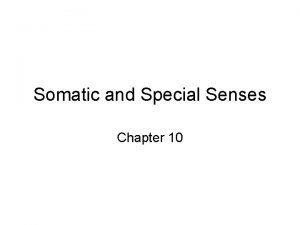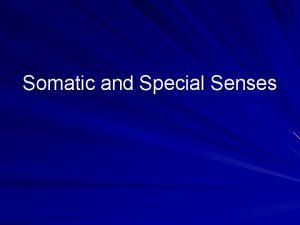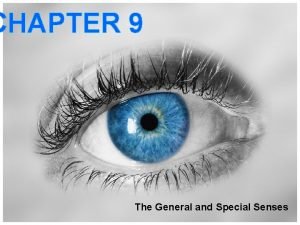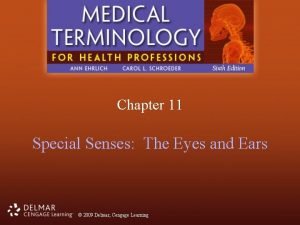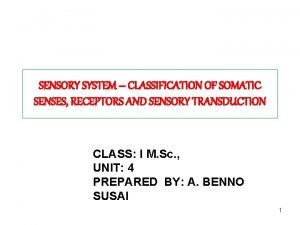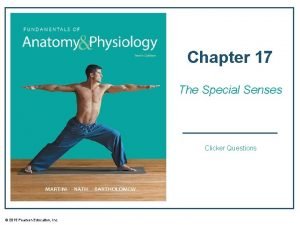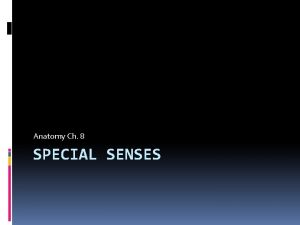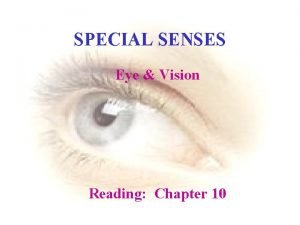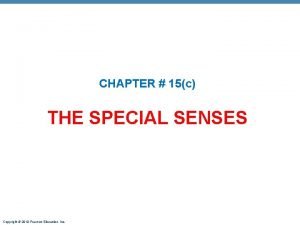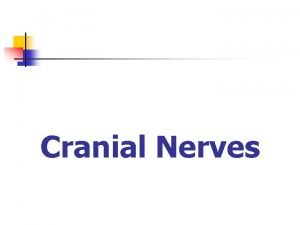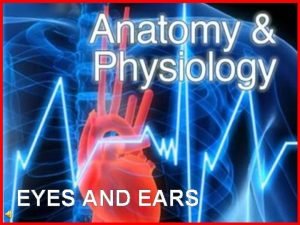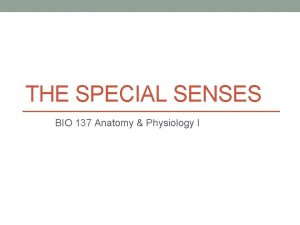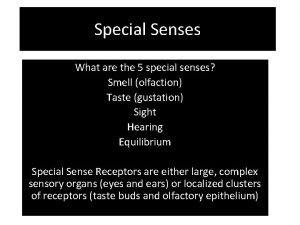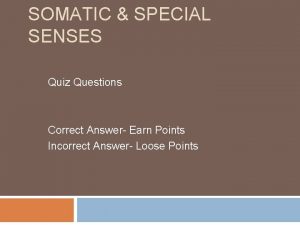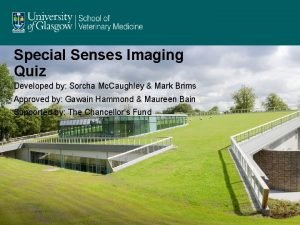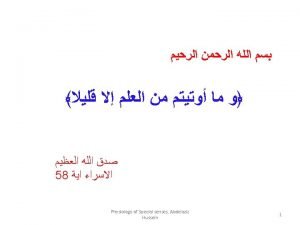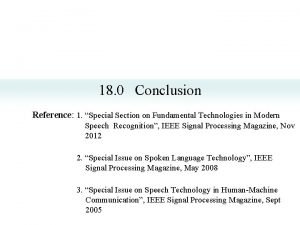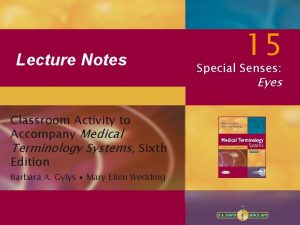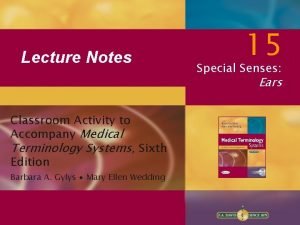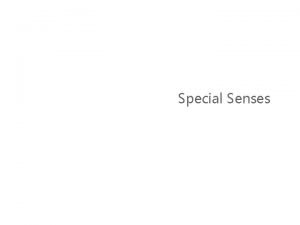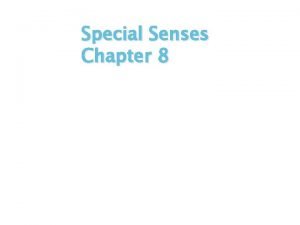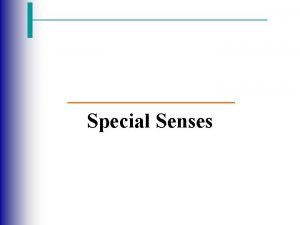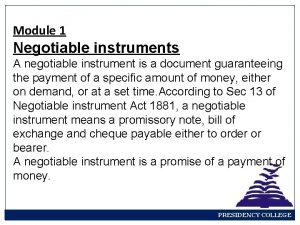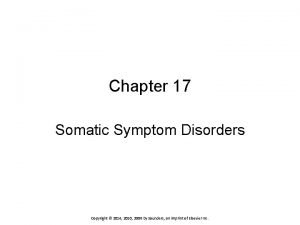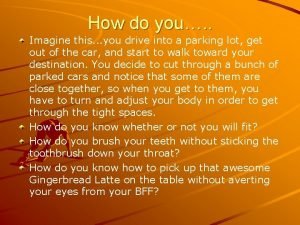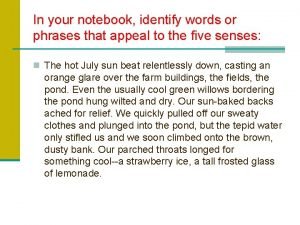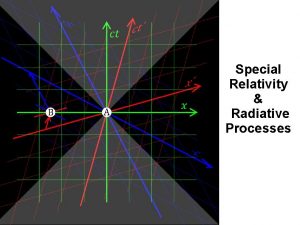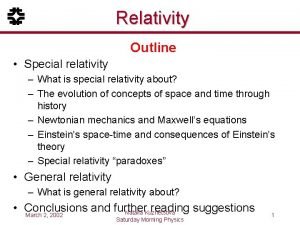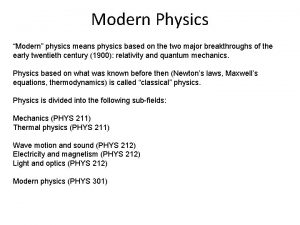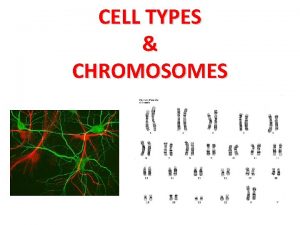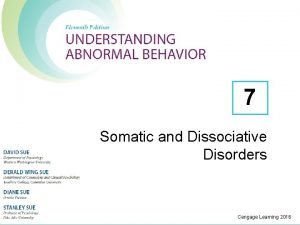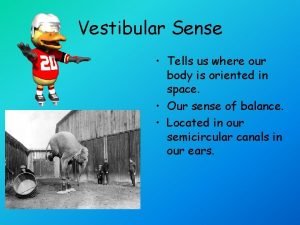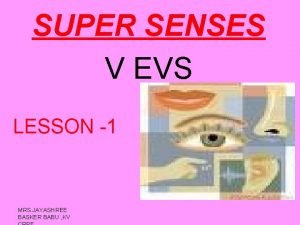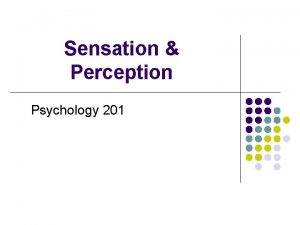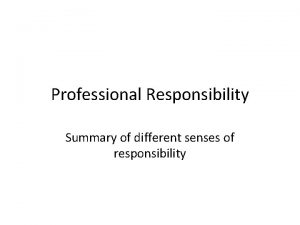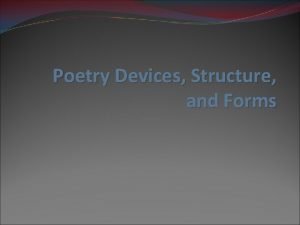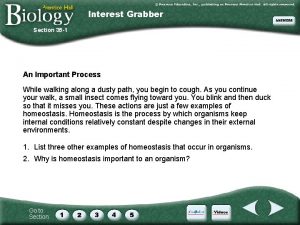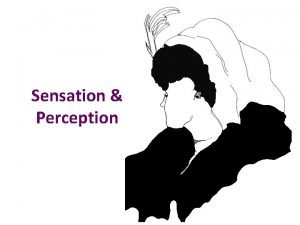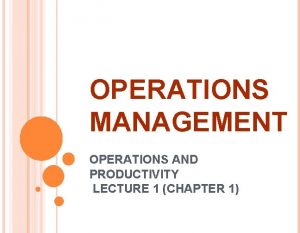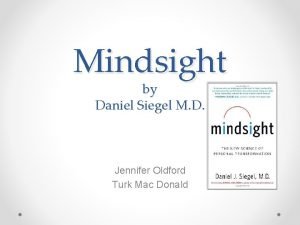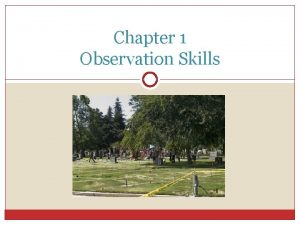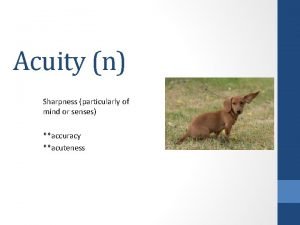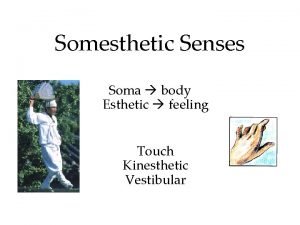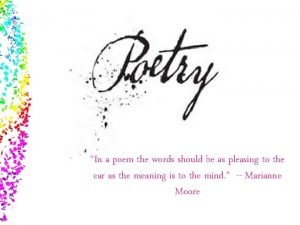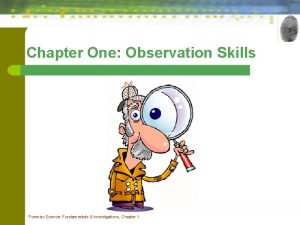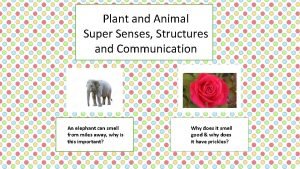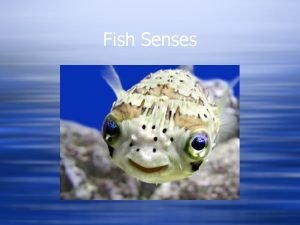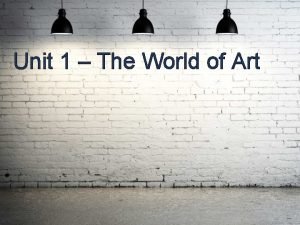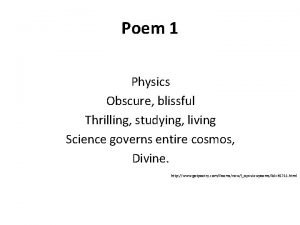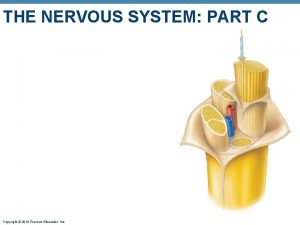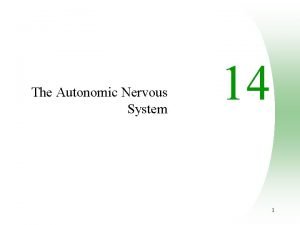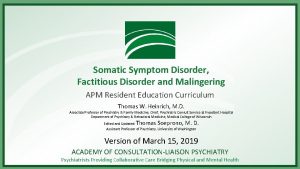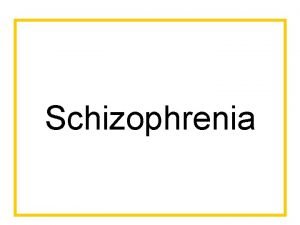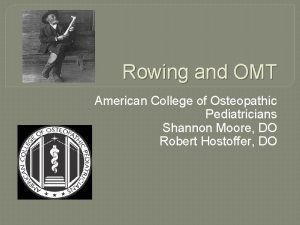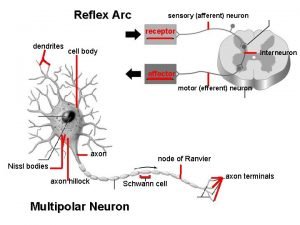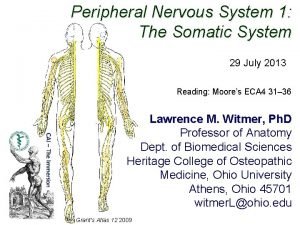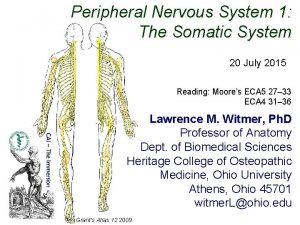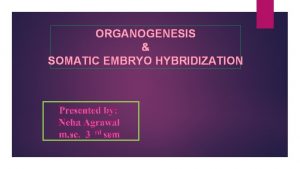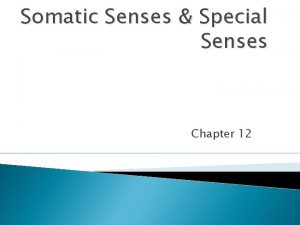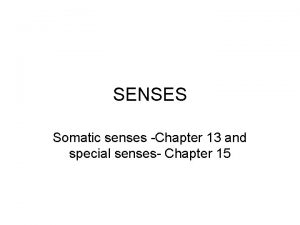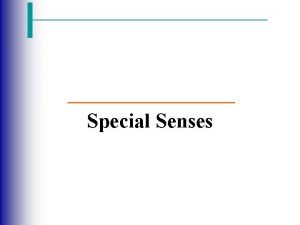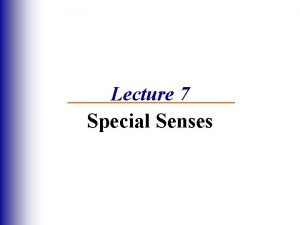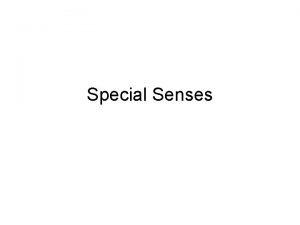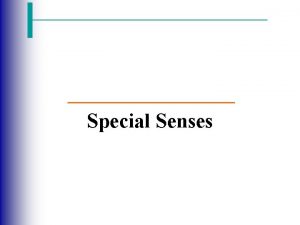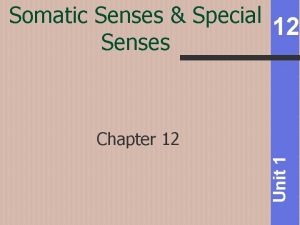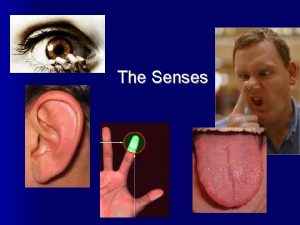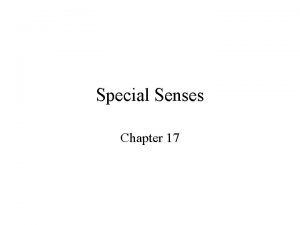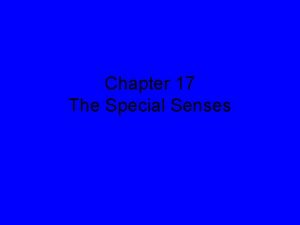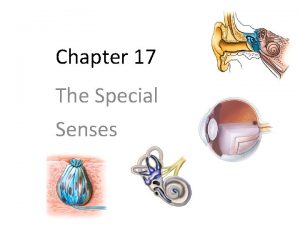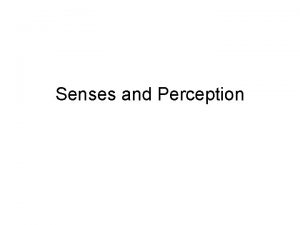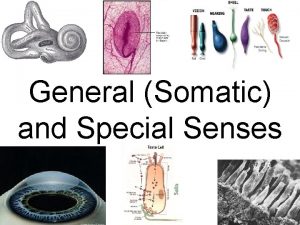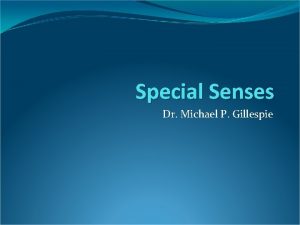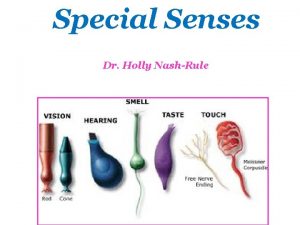Chapter 12 Somatic and Special Senses Somatic General






















































































- Slides: 86

Chapter 12 Somatic and Special Senses Somatic (General) Senses • receptors that are widely distributed throughout the body • skin, various organs and joints Special Senses • specialized receptors confined to structures in the head • eyes, ears, nose, mouth 1

Senses Sensory Receptors • specialized cells or multicellular structures that collect information from the environment • stimulate neurons to send impulses along sensory fibers to the brain Sensation • a feeling that occurs when brain becomes aware of sensory impulse Perception • a person’s view of the stimulus; the way the brain interprets the information 2

Pathways From Sensation to Perception (Example of an Apple) 3

Receptor Types - General Chemoreceptors • respond to changes in chemical concentrations Pain receptors • respond to tissue damage Thermoreceptors • respond to changes in temperature 4

• Mechanoreceptors • respond to mechanical forces proprioceptors –tensions of muscles and tendons baroreceptors – blood pressure stretch receptors – inflation in lungs Photoreceptors • respond to light 5

Sensory Impulses • Stimulation causes a change in membrane potential • Nerve fiber. Sensory receptors can be ends of nerve fibers or other cells close to them • generates an action potential and an impulse is sent • Peripheral nerves transmit the impulse to the CNS • CNS analyzes and interprets the impulse 6

Sensations • Feelings that occur when the brain interprets sensory impulses • All nerve impulses are the same • Sensation depends on which area of the cerebral cortex receives the impulse • Receptors usually respond to specific stimuli so the brain creates the correct sensation 7

• Cerebral cortex interprets the impulse to come from the receptors stimulated • Projection allows a person to pinpoint the region of stimulation Ex: eyes see and the nose smells things 8

Sensory Adaptation • Occurs when sensory receptors are continuously stimulated • As receptors adapt impulses leave at decreasing rates and may stop entirely • Impulses are only triggered if the strength of the stimulus changes Ex: adjusting to bad smell in a room 9

Somatic (General) Senses • senses associated with skin, muscles, joints, and viscera • three groups • exteroceptive senses – senses associated with body surface; touch, pressure, temperature, pain • visceroceptive senses – senses associated with changes in viscera; blood pressure stretching blood vessels, ingesting a meal • proprioceptive senses – senses associated with changes in muscles and tendons 10

Touch and Pressure Senses mechanical forces that deform or displace tissue 3 types • Sensory nerve fibers – found in epithelial tissue associated with touch and pressure • Meissner’s corpuscles – small oval masses of connective tissue found in hairless part of the skin(lips, palms etc. ) sense light touch and texture 11

• Pacinian corpuscles – large masses of connective tissue fibers and cells found in subcutaneous tissues stimulated by heavy pressure 12

Touch and Pressure Receptors 13

Temperature Senses Heat receptors • sensitive to temperatures above 25 o. C (77 o F) • unresponsive to temperature above 45 o. C (113 o. F) Cold receptors • sensitive to temperature between 10 o. C (50 o. F) and 20 o. C (68 o. F) • Both cold and heat receptors rapidly adapt Pain receptors • respond to temperatures below 10 o. C • respond to temperatures above 45 o. C 14

Pain Receptors • Consist of free nerve endings are located in the skin and internal tissues, except the nervous tissue of the brain • Stimulated when tissue is damaged • Usually specific to the type of pain • Adapt very little, if at all 15

Visceral Pain • pain receptors are the only receptors in viscera whose stimulation produces sensations • pain receptors respond differently to stimulation • not well localized • may feel as if coming from some other part of the body • known as referred pain • an example would be heartburn 16

Pain Nerve Pathways Acute pain fibers • A-delta fibers • thin, myelinated • conduct impulses rapidly • associated with sharp pain • well localized Chronic pain fibers • C fibers • thin, unmyelinated • conduct impulses more slowly • associated with dull, aching pain • difficult to pinpoint 17

• An event may trigger impulses on both types of fibers • causing a dull sensation • a sharp pain then a dull aching one • aching pain is usually more intense and may worsen over time • Awareness of pain occurs when the impulse reaches the thalamus • Cerebral cortex judges the intensity and locates the source of pain 18

• Midbrain, pons, and medulla oblongata regulate the flow of impulses from the spinal cord • Neuropeptides (endorphins) inhibit pain sensations • enkephalins and endorphins can suppress chronic and acute pain impulses • serotonin stimulates other neurons to release enkephalins 19

Stretch Receptors 20

Stretch Receptors • Proprioceptors that sense length and tensions of muscles - 2 main types Muscle spindles • found in muscles near junctions with tendons • responds to a muscle stretching (stretch reflex) • helps maintain the desired position of a limb 21

Golgi tendon organs • found in tendons close to muscle attachments • stimulated by increased tension • helps maintain posture and protects muscles from being torn away from attachments 22

Special Senses • sensory receptors are within large, complex sensory organs in the head • smell in olfactory organs • taste in taste buds • hearing and equilibrium in ears • sight in eyes 23

Sense of Smell Olfactory Receptors • chemoreceptors • respond to chemicals dissolved in liquids Olfactory Organs • contain olfactory receptors (bipolar neurons) and supporting epithelial cells • cover parts of nasal cavity, superior nasal conchae, and a portion of the nasal septum 24

Olfactory Receptors 25

Olfactory Nerve Pathways Once olfactory receptors are stimulated, nerve impulses travel through • olfactory nerves olfactory bulbs olfactory tracts limbic system (for emotions) and olfactory cortex in cerebrum(for interpretation) • The only nerve cells in direct contact to the outside environment • the only neurons that are regularly replaced (subject to damage) yet about 1% are lost every year • sense of smell diminishes with age 26

Olfactory Stimulation • olfactory organs located high in the nasal cavity above the usual pathway of inhaled air • olfactory receptors undergo sensory adaptation rapidly • sense of smell drops by 50% within a second after stimulation Olfactory Code • hypothesis • each odor may stimulate a specific set of receptor subtypes 27

Sense of Taste Buds • organs of taste • located on papillae of tongue, roof of mouth, linings of cheeks and walls of pharynx Taste Receptors • chemoreceptors • taste cells – modified epithelial cells that function as receptors • taste hairs –microvilli that protrude from taste cells; sensitive parts of taste cells 28

Taste Receptors 29

Taste Sensations Primary Taste Sensations • sweet – • sour – • salty – • bitter – • umami(savory) – taste of glutamate (MSG) • Food must be dissolved in saliva to be tasted • Taste cells are modified epithelial cells that are replaced continually – taste does not diminish with age 30

Hearing Ear – organ of hearing Three Sections • External • Middle • Inner 31

External ear • outer structure called auricle - collects sound waves and directs them inward • external auditory meatus leads inward about 2. 5 cm • lined with skin that has modified sweat glands that secrete wax • hairs guard the opening • sound waves pass to the end alter the pressure on the tympanic membrane (eardrum) 32

Ear 33

Middle Ear • Includes the tympanic membrane, tympanic cavity, and 3 small bones called auditory ossicles (malleus, incus, stapes) • Tympanic cavity is an air-filled space in the temporal bone that separates the external and internal ears • Tympanic membrane covered by a thin layer of skin on outer surface and mucous membrane on the inside 34

• Auditory ossicles transmit vibrations between the tympanic membrane and inner ear Malleus, incus and stapes • Vibration on the stapes moves fluid within the inner ear which stimulates hearing receptors • Oval window is an opening in the wall of tympanic cavity where the stapes is attached by ligaments 35

• Tympanic reflex reduces pressure from loud sounds that might damage receptors – ossicles become more rigid • Auditory Tube (Eustachian tube) • Connects each middle ear to the throat • Allows air to pass between the tympanic cavity and outside the body 36

• Helps maintain equal pressure on both sides of the tympanic membrane- needed for normal hearing • air pressure changes with altitude causing ears to pop • usually closed by valvelike flaps in the throat • swallowing, yawning, and chewing help open the valves and equalize the pressure 37

Inner Ear • Complex system of intercommunicating chambers called labyrinth – each ear has 2 regions • osseous labyrinth – bony canal in temporal bone • membraneous labyrinth – a tube within the osseous labyrinth • perylymph is fluid between the 2 chambers 38

• endolymph is fluid in the membraneous labyrinth • cochlea contains the organ of Corti which contains the receptors (hair cells) that vibrations in the fluid stimulates • different frequencies stimulate different receptors • humans can detect sound waves with frequencies from 20 - 20, 000 vibrations/second • semicircular canals provide a sense of equilibrium 39

Inner Ear 40

Organ of Corti 41

Auditory Nerve Pathways • Nerve fibers from hearing receptors travel in the cochlear branch of the vestibulocochlear nerves • Impulses travel to the medulla oblongata, midbrain, thalamus, and are interpreted in the temporal lobes of the cerebrum 42

Auditory Nerve Pathways 43

Summary of the Generation of Sensory Impulses from the Ear 44

Sense of Equilibrium Static Equilibrium • Maintains the stability of the head and body when they are motionless • Organs of static equilibrium are the vestibule (bony chamber between the semicircular canals and cochlea) 45

• Sensory receptors are hair cells in a gelatinous material that sense changes in position • Movements tilt the gelatinous mass which stimulates the hair cells to signal nerve fibers • Brain responds by sending impulses to skeletal muscles to contract or relax in order to maintain balance 46

Vestibule 47

Macula • responds to changes in head position • bending of hairs results in generation of nerve impulse 48

Dynamic Equilibrium • Balances the head and body when they are moved or rotated suddenly • Sense organs (hair cells) are located in the ampullae of the semicircular canals • Sudden movements cause the hair cells to bend and send an impulse to the brain • Parts of the cerebellum also interpret information from the semicircular canals and help maintain balance • Visual information is also used to maintain balance 49

Semicircular Canals 50

Crista Ampullaris 51

Equilibrium Static Equilibrium • vestibule • sense position of head when body is not moving Dynamic Equilibrium • semicircular canals • sense rotation and movement of head and body 52

Sight Visual Accessory Organs • The eye, eyelid, lacrimal gland, and extrinsic muscles are located in the orbital cavity of the skull • The orbit is lined with bone, fat, blood vessels, nerves, and connective tissue 53

Visual Accessory Organs 1. Each eyelid is made of 4 layers: skin, muscle, connective tissue, and conjuctiva 2. The conjunctiva is a mucus membrane that lines the inner surface of the eyelids and fold back to cover the anterior surface of the eyeball 54

3. The lacrimal gland secretes tears and a series of ducts carry the tears into the nasal cavity 55

Lacrimal Apparatus 56

Extrinsic Eye Muscles • The extrinsic muscles are associated with one primary action although eye movements may use more than one muscle 57

Extrinsic Eye Muscles 58

Structure of the Eye • It is a hollow, spherical structure about 2. 5 cm in diameter • Has 3 distinct layers: outer fibrous tunic, a middle vascular tunic, and an inner nervous tunic. • Spaces within the eye are filled with fluid to provide support and maintain shape 59

The Outer Tunic • Cornea is transparent and helps focus light rays - anterior portion of eye - contains few cells and blood vessels - many nerve fibers • Sclera is the white part of the eye - protects the eye and is an attachment for muscles 60

• Optic nerve is located in the back of the eye - pierces the sclera - carries impulses to brain 61

Structure of the Eye 62

The Middle Tunic • The choroid coat loosely joins the sclera • many blood vessels to nourish tissues • contains melanocytes (produces pigment) that absorb excess light and helps keep inside of eye dark • The ciliary body extends forward from the choroid coat • ligaments extend to hold the lens in place 63

• ciliary muscles contract to view a close object and relax to view a distant object • The lens is a clear membraneous structure • light passes through • cataracts form when the lens becomes cloudy and clear images can’t be focused on the retina • Iris controls amount of light entering pupil 64

Lens • transparent • biconvex • lies behind iris • largely composed of lens fibers • elastic • held in place by suspensory ligaments of ciliary body 65

Ciliary Body • forms internal ring around front of eye • ciliary processes – radiating folds • ciliary muscles – contract and relax to move lens 66

Accommodation • changing of lens shape to view objects 67

Iris • composed of connective tissue and smooth muscle • pupil is hole in iris • dim light stimulates radial muscles and pupil dilates • bright light stimulates circular muscles and pupil constricts 68

Aqueous Humor • fluid in anterior cavity of eye • secreted by epithelium on inner surface of the ciliary body • provides nutrients • maintains shape of anterior portion of eye 69

Inner Tunic • retina • contains visual receptors • continuous with optic nerve • ends just behind margin of the ciliary body • composed of several layers • macula lutea – yellowish spot in retina • fovea centralis – center of macula lutea; produces sharpest vision • optic disc – blind spot; contains no visual receptors • vitreous humor – thick gel that holds retina flat against choroid coat 70

Posterior Cavity • contains vitreous humor – thick gel that holds retina flat against choroid coat 71

Major Groups of Retinal Neurons • receptor cells, bipolar cells, and ganglion cells - provide pathway for impulses triggered by photoreceptors to reach the optic nerve • horizontal cells and amacrine cells – modify impulses 72

73

Layers of the Eye 74

Light Refraction • bending of light • occurs when light waves pass at an oblique angle into mediums of different densities 75

Types of Lenses Convex lenses cause light waves to converge Concave lenses cause light waves to diverge 76

Focusing On Retina • as light enters eye, it is refracted by • convex surface of cornea • convex surface of lens • image focused on retina is upside down and reversed from left to right 77

Visual Receptors Rods • long, thin projections • contain light sensitive pigment called rhodopsin • hundred times more sensitive to light than cones • provide vision in dim light • produce colorless vision • produce outlines of objects Cones • short, blunt projections • contain light sensitive pigments called erythrolabe, chlorolabe, and cyanolabe • provide vision in bright light • produce sharp images • produce color vision 78

Rods and Cones 79

Visual Pigments Rhodopsin • light-sensitive pigment in rods • decomposes in presence of light • triggers a complex series of reactions that initiate nerve impulses • impulses travel along optic nerve Pigments on Cones • each set contains different lightsensitive pigment • each set is sensitive to different wavelengths • color perceived depends on which sets of cones are stimulated • erythrolabe – responds to red • chlorolabe – responds to green • cyanolabe – responds to blue 80

Stereoscopic Vision • provides perception of distance and depth • results from formation of two slightly different retinal images 81

Visual Nerve Pathway 82

Life-Span Changes Age related hearing loss due to • damage of hair cells in organ of Corti • degeneration of nerve pathways to the brain • tinnitus Age-related visual problems include • dry eyes • floaters (crystals in vitreous humor) • loss of elasticity of lens (presbyopia) need reading glasses • glaucoma • cataracts • macular degeneration 83

Clinical Application Refraction Disorders • concave lens corrects nearsightedness (myopia) • convex lens corrects farsightedness (hyperopia) 84

• Astigmatism - curvature of cornea is elliptical rather than spherical - some portions of the image are in focus and some are blurred - eyes try to accommodate which leads to ciliary muscle fatigue and headaches

• Presbyopia (farsightedness of age) - eye losses refractive power with age - unable to accommodate to see close objects - Ciliary muscles lose ability to contract - need reading glasses
 What is the difference between somatic and special senses
What is the difference between somatic and special senses Messiners
Messiners Chapter 10 somatic and special senses
Chapter 10 somatic and special senses Somatic and special senses
Somatic and special senses The general and special senses chapter 9
The general and special senses chapter 9 Ear bone structure
Ear bone structure Chapter 11 learning exercises medical terminology
Chapter 11 learning exercises medical terminology Anatomy and physiology chapter 8 special senses
Anatomy and physiology chapter 8 special senses Receptor types
Receptor types Chapter 17 special senses answer key
Chapter 17 special senses answer key Chapter 8 special senses
Chapter 8 special senses Emmentropia
Emmentropia Chapter 15 special senses
Chapter 15 special senses Chapter 15 special senses
Chapter 15 special senses Cranial nerves and special senses
Cranial nerves and special senses Special senses the eyes and ears
Special senses the eyes and ears Special senses physiology
Special senses physiology What are the special senses
What are the special senses Special senses physiology
Special senses physiology Special senses quiz
Special senses quiz Physiology
Physiology Signal conclusion
Signal conclusion Building vocabulary activity: the special senses
Building vocabulary activity: the special senses Building vocabulary activity: the special senses
Building vocabulary activity: the special senses Special senses anatomy
Special senses anatomy Lacrimal fluid
Lacrimal fluid The general senses
The general senses Types of somatic disorder
Types of somatic disorder Sans recourse endorsement
Sans recourse endorsement Synchronic lexicology deals with
Synchronic lexicology deals with Chapter 17 somatic symptom disorders
Chapter 17 somatic symptom disorders 5 elements and 5 senses
5 elements and 5 senses Facts about taste
Facts about taste Kinesthesis and vestibular sense
Kinesthesis and vestibular sense In your notebook identify the function
In your notebook identify the function Special relativity vs general relativity
Special relativity vs general relativity General vs special relativity
General vs special relativity Modern physics means
Modern physics means General relativity vs special relativity
General relativity vs special relativity Diploid cell
Diploid cell Dissociative
Dissociative Nervous system chart
Nervous system chart Somatic and autonomic nervous system
Somatic and autonomic nervous system Somatic death
Somatic death Diferencia entre gran plano general y plano general
Diferencia entre gran plano general y plano general Where did general lee surrender to general grant?
Where did general lee surrender to general grant? Vestibular sense
Vestibular sense Language
Language 5 taste senses
5 taste senses Five super senses of tiger
Five super senses of tiger Describing the beach using 5 senses
Describing the beach using 5 senses Descriptive essay beach using five senses
Descriptive essay beach using five senses Perception
Perception Senses of responsibility
Senses of responsibility Types of descriptive language
Types of descriptive language Section 35-5 drugs and the nervous system answer key
Section 35-5 drugs and the nervous system answer key Human input output channels in hci
Human input output channels in hci 5 senses
5 senses Absolute threshold psychology definition
Absolute threshold psychology definition Operations management productivity problems
Operations management productivity problems Jennifer siegel md
Jennifer siegel md What a person perceives using his or her senses
What a person perceives using his or her senses Sharpness (particularly of the mind or senses)
Sharpness (particularly of the mind or senses) Body esthetic
Body esthetic Bio poem definition
Bio poem definition Why are observation skills important to forensic science
Why are observation skills important to forensic science Elephant super senses
Elephant super senses Vision in fishes
Vision in fishes Multiple senses of lexical items
Multiple senses of lexical items Physical function of art
Physical function of art Willingness dbt
Willingness dbt Physics poem about life
Physics poem about life Physical characteristics of a cheetah
Physical characteristics of a cheetah Which senses does kunene use in this poem
Which senses does kunene use in this poem Spinal cord diagram
Spinal cord diagram Somatic reflex vs visceral reflex
Somatic reflex vs visceral reflex Somatic vs factitious
Somatic vs factitious Sns somatic nervous system
Sns somatic nervous system Somatic motor pathway
Somatic motor pathway Gametic cells vs somatic cells
Gametic cells vs somatic cells Ideas of reference
Ideas of reference Caliper motion of ribs
Caliper motion of ribs Site of somatic motor neuron cell bodies
Site of somatic motor neuron cell bodies Sam byron
Sam byron Visceral vs somatic sensory
Visceral vs somatic sensory Erb palsy
Erb palsy Process of somatic embryogenesis
Process of somatic embryogenesis


